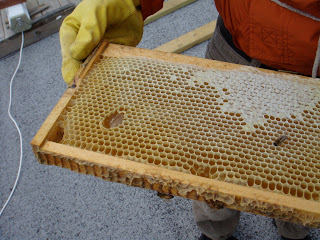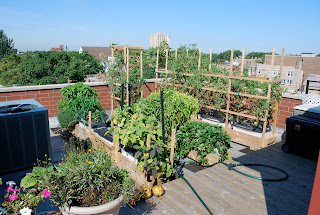Well, it's new to us anyway. Based on many posts over at Inside Urban Green on using
wicking fabric in sub irrigation, I contacted Greenscaper Bob for a little assist on how best to use absorbent fabric to wick water up into our 5-gal
SIPs.
He advised making slits and criss-crossing strips of the fabric at the bottom of the top bucket, letting the ends drape down into the water reservoir.
I asked my sister the accomplished seamstress if she ever ran into
pellon thermolam plus (recommended by Bob) on her frequent fabric store visits. Next thing I knew, she'd brought me a big roll of it, tied up in a pretty bow.

Over Memorial Day weekend, niece Brooke and her pal Amy came over to learn how to make SIPs. We were also going to work on the fabric wicking project, but got sidetracked by rain.
Still, we got the fabric strips cut.

A few days later I tried to cut the bucket slits with a utility knife, but those food-grade buckets are tough customers. Gardeners' friend to the rescue.
I marked the bucket...

...and Art used a small circular saw
to get it done in no time.

Once threaded, Art wondered if we possibly wanted more wet fabric to touch the soil. Duh--why didn't I think of that? Thanks to Homegrown Evolution for making me feel better about making mistakes with this
lovely quote from Mark Frauenfelder's new book
Made By Hand, which we picked up from the library this week.
Art re-cut the slits closer to the edge
and I soaked the fabric and threaded it through.

Here are the ends,
which sit down in the water reservoir.

And the result? This tomato looks just as happy as the SIPs with soil-loaded wicking cups. Using fabric eliminates one more plastic component from SIP-building. If you've never seen Bruce's post on the
dizzying status of various plastics, it's a worthwhile read and a real motivator.
Thanks for the help,
Greenscaper Bob!

Brooke and Amy, two smart, curious librarians who work with children at the Fremont Public Library District, did their homework before coming over on Memorial Day, reading up on sub irrigation. They "got it" immediately when I showed them the components and we planted two peppers before the storms came.
Well done, you two.
Now go show the kids how to do it...

I get by with a little help from my friends...











































